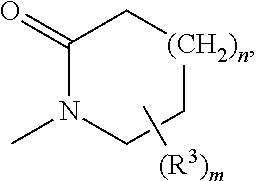Compounds for the Treatment of Metabolic Disorders
a metabolic disorder and compound technology, applied in the field of therapeutic compounds, can solve the problems of high potential side effects of drugs aimed at the pathophysiology associated with non-insulin dependent type ii diabetes, and insufficiently addressing the dyslipidaemia and hyperglycaemia in a high proportion of patients
- Summary
- Abstract
- Description
- Claims
- Application Information
AI Technical Summary
Benefits of technology
Problems solved by technology
Method used
Image
Examples
examples
Materials and Methods
[0137]Column chromatography was carried out on SiO2 (40-63 mesh) unless specified otherwise. LCMS data were obtained as follows: Atlantis 3μ C18 column (3.0×20.0 mm, flow rate=0.85 mL / min) eluting with a H2O-MeCN solution containing 0.1% HCO2H over 6 min with UV detection at 220 nm. Gradient information: 0.0-0.3 min 100% H2O; 0.3-4.25 min: Ramp up to 10% H2O-90% MeCN; 4.25-4.4 min: Ramp up to 100% MeCN; 4.4-4.9 min: Hold at 100% MeCN; 4.9-6.0 min: Return to 100% H2O. The mass spectra were obtained using an electrospray ionisation source in either the positive (ES+) or negative (ES−) ion modes.
[0138]LCMS-method 2 data were obtained as follows: Xbridge C18 column (2.1×50 mm, 2.5 μM, flow rate 0.8 mL / min) eluting with an MeCN-10 mM NH4HCO3 solution over 1.5 min with UV detection at 215-350 nm. Gradient information: 0-0.8 min: 98% MeCN 2% NH4HCO3 to 98% NH4HCO3 2% MeCN; 0.8-1.2 min: hold at 98% NH4HCO3 2% MeCN. The mass spectra were obtained using an electrospray io...
preparation 1
4-[5-(6-Chloropyridin-3-yl)-[1,2,4]oxadiazol-3-ylmethoxy]piperidine-1-carboxylic acid tert-butyl ester
[0144]
[0145]To a solution of 6-chloronicotinic acid (500 mg, 3.17 mmol) in THF (25 mL) was added EDCI (0.74 g, 3.89 mmol), followed by HOBt (583 mg, 3.81 mmol), and the reaction was stirred at r.t. for 10 min. 4-(N-Hydroxycarbamimidoylmethoxy)piperidine-1-carboxylic acid tert-butyl ester (866 mg, 3.17 mmol) was added and the reaction was stirred at r.t. for 16 h before removing the solvent in vacuo. The resulting residue was partitioned between EtOAc (100 mL) and water (50 mL). The organic phase was separated, washed with sat. NaHCO3 solution, then brine, and dried (MgSO4), before removal of the solvent in vacuo. The residue was dissolved in toluene and the reaction heated to 110° C. for 16 h. Removal of the solvent in vacuo and purification by column chromatography (IH:EtOAc, 70:30) afforded the title compound: RT=3.97 min, m / z (ES+)=395.2 [M+H]+.
preparation 2
4-[5-(2-Chloropyrimidin-5-yl)-[1,2,4]oxadiazol-3-ylmethoxy]piperidine-1-carboxylic acid tert-butyl ester
[0146]
[0147]To a solution of 2-chloropyrimidine-5-carboxylic acid (100 mg, 0.63 mmol) in THF (10 mL) was added 1,3-diisopropylcarbodiimide (99 μL, 0.63 mmol) and the reaction was stirred at r.t. for 10 min. 4-(N-Hydroxycarbamimidoylmethoxy)piperidine-1-carboxylic acid tert-butyl ester (172 mg, 0.63 mmol) was added and the mixture was stirred at r.t. for 72 h. The reaction solvent was removed in vacuo and the resulting residue was re-dissolved in EtOAc (100 mL). The organic mixture was washed with water, then brine, and dried (MgSO4), before removal of the solvent in vacuo. The resulting residue was dissolved in toluene and heated to 80° C. for 16 h. Removal of the solvent in vacuo and purification by column chromatography (IH:EtOAc, 60:40) afforded the title compound: RT=3.77 min, m / z (ES+)=396.1 [M+H]+.
PUM
| Property | Measurement | Unit |
|---|---|---|
| body weight | aaaaa | aaaaa |
| flow rate | aaaaa | aaaaa |
| flow rate | aaaaa | aaaaa |
Abstract
Description
Claims
Application Information
 Login to View More
Login to View More - R&D
- Intellectual Property
- Life Sciences
- Materials
- Tech Scout
- Unparalleled Data Quality
- Higher Quality Content
- 60% Fewer Hallucinations
Browse by: Latest US Patents, China's latest patents, Technical Efficacy Thesaurus, Application Domain, Technology Topic, Popular Technical Reports.
© 2025 PatSnap. All rights reserved.Legal|Privacy policy|Modern Slavery Act Transparency Statement|Sitemap|About US| Contact US: help@patsnap.com



